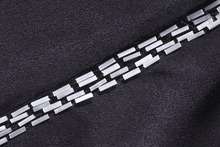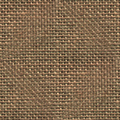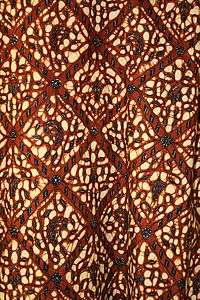Crêpe (textile)
_LACMA_41.11.8.jpg)
Crêpe or crape (from the Fr. crêpe[1]) is a silk, wool, or synthetic fiber fabric with a distinctively crisp, crimped appearance. The term crape typically refers to a form of the fabric associated specifically with mourning,[2] also historically called crespe or crisp.[3]
Types
Types (A to C)
.jpg)
- Aerophane:
- Crimped silk gauze with a crêpe texture.
- A historic 19th century lightweight crêpe,[4] introduced in 1820,[5] and, as crepe aerophane in 1861.[6]
- Albert crêpe:
- A superior-quality black silk mourning crêpe used since 1862.[5]
- Plain-weave crêpe.
- An English-made silk and cotton blend crêpe.[7]
- Alicienne: A furnishing fabric with alternating plain weave and crêpe stripes.[8]
- Alpaca crêpe: Rayon and acetate blend crêpe with a woollen texture, not necessarily made of alpaca yarn.[8]
- Altesse: A British plain-weave silk fabric with crêpe filling.[9]
- Arabian:
- A British-made plain-weave cloth with figured crêpe designs
- Piece-dyed silk crêpe embroidered with dots.[10]
- Armure See Georgian crêpe.
- Balanced crêpe: Crêpe woven with alternating S and Z twist yarns in both directions.[11]
- Balmoral crape: An 1895 English crape.[12]
- Balzerine: An 1889 narrow-striped silk grenadine overlaid with wider crêpe stripes. An earlier 1830s cotton/worsted fabric, spelled balzarine, is probably not crêpe.[12]
- Bark (or tree-bark) crêpe: A broad term describing rough crêpes with a bark texture.[13][14]
- Bauté satin: Warp-woven satin with a plain crêpe reverse.[15]
- Borada crape: A cheaper, economical version of mourning crape advertised in c.1887.[3]
- Bologna crêpe: Silk crêpe used for mourning, also known as valle cypre.[16]
- Canton crêpe: A soft silk crêpe with a pebbly surface originally associated with Canton in China, with bias ribs. Made in Britain, but exported to China, hence its name.[17]
- Caustic soda crêpe: Cotton treated with chemicals to create a crêpe-like texture, often in patterns.[18]
- Chiffon crêpe: Chiffon-weight crêpe.[19]
- Chijimi: Japanese crêpe.[19]
_of_rayon.jpg)
- Chirimen: Japanese raw silk crêpe widely used for kimonos.[20][21] When woven with a dot it is mon-chirimen.[22]
- Courtauld crape: 1890s mourning crape made by Courtaulds. An 1894 variation, called Courtauld's new silk crêpe, was exceptionally thin and soft.[6] Courtaulds monopolised the export market for English crapes and crêpes, meaning that the textiles known as crape anglaise were almost always manufactured by Courtaulds up until 1940.[3]
- Crêpe Algerian: A trade name for a printed pongee with a rough crêpe texture.[23]
- Crêpe anglaise: A French term for English mourning crapes in black and white.[6] The only true 'crape anglais' was considered that made by Courtaulds (see Courtauld crape) which was last made in 1940.[3]
- Crêpe Beatrice: Trade name for crêpe with a light warp stripe.[23]
- Crêpe berber: Trade name for a piece-dyed crepe-textured pongee.[24]
- Crêpe charmeuse: Lightweight silk satin with a grenadine warp and crêpe reverse.[24]
- Crêpe chenette: A tradename for a strong crêpe with a pebble texture.[24]
- Crêpe crêpe: Made with extra twists in the warp to create an extra-deep texture.[24]

- Crêpe de chine: A fine, lightweight silk, cotton, or worsted, with a plain weave and crêpe-twist filling.[24]
- Crêpe de chine travers: A ribbed crêpe de chine with heavier filling yarns introduced to the weave at regular intervals.[24]
- Crêpe de dante: Crêpe with silk and wool filling.[24]
- Crêpe de lahor: Cotton crêpe made in France.[24]
- Crêpe de laine: A sheer wool fabric plain-woven with hard twist for a slight crêpe effect.[24]
- Crêpe de santé: An undyed, closely woven, rough-textured wool-blend crêpe mixed with silk, linen or cotton, also called "health crepe"[24]
- Crêpe de Suisse: 1860 dress fabric.[6]
- Crêpe d'espagne: Open-weave fabric with a silk warp and wool filling.[24]
- Crêpe diana: Trade name for a cotton and silk blend crêpe.[24]
- Crêpe Elizabeth: English term for a mottled or pebbled georgette.[24]
- Crêpe faille sublime: Silk grosgrain with a hard-twist filling.[24]
- Crêpe flannel: Plain-woven worsted with a crêpe finish.[24]
- Crêpe imperial Late 19th century woollen crape.[6]
- Crêpe jacquard: Crepe with designs produced by jacquard weaving.[24]
- Crêpe janigor: Trade name for a heavy rib textile with alternating rayon and dull acetate warp threads, cross-dyed for varied shades.[24]
- Crêpe jersey: Vertically ribbed silk crêpe resembling the knit fabric.[24]
- Crêpe lissé (or lease): A lightweight, lustrous, slightly stiffened open-weave silk or cotton crêpe, with fewer twists than a crêpe crêpe.[24]
- Crêpela: French term for a crêpe effect.[24]
- Crepeline: Very sheer plain-woven silk usually used in textile conservation.[24] Originally introduced in the 1870s as a cheap alternative to crepe de chine.[6]
- Crêpella: Plain-woven worsted using hard-spun yarn.[24]
- Crêpe maretz An 1862 fabric.[6]
- Crêpe marocain: Heavy, cross-ribbed crêpe where the filling yarn is coarser than the warp, resembling a canton crêpe.[24]
- Crêpe meteor: Soft silk crêpe, twill weave reversing to satin.[24]
- Crêpe mohair: Silk and mohair blend crêpe.[24]
- Crêpe morette: Trade name. Lightweight worsted crêpe with heavier, looser filling.[24]
- Crêpe mosseux: A type of opaque voile which resists shrinkage.[24]
- Crêpe myosotis A later mourning crêpe made in the 1930s, in crimped silk with a soft finish.[6] Courtaulds launched this textile in the early 1930s as an alternative to the increasingly unpopular traditional stiff mourning crapes.[3]
- Crepenette: Crêpe-effect pongee.[24]
- Crêpe ondese: Rough textured rayon-acetate blend crêpe.[24]
- Crêpe poplin: A late 19th century silk-wool rib fabric with crêpe effect.[24]
- Crêpe rachel: French print cotton-worsted blend crêpe.[24]
- Crêpe radio: British raw silk crêpe with a ribbed effect, using alternate double rows of S-twist and Z-twist.[24]
- Crêpe royal: Sheer crêpe-de-chine introduced in 1889.[6]
- Crêpe suzette: A variation on crepon georgette.[24]
- Crepine: Silk with crêpe dots. The name also describes a type of fringe.[24]
- Crepoline: A class of transparent fabrics with a warp-wise crêpe effect.[24]
- Crepon: A heavier crêpe with an exaggerated warp-directional texture produced by several weaving techniques.[24] A soft silky version was introduced in 1866, and the second, much heavier version in 1882. In the 1890s crepon also described a woollen fabric that puffed between stripes or squares, including crepon milleraye (striped) and crepon Persian (with 'Oriental patterns').[6]
- Crystal crêpe: An English term for silk crêpe.[25]
- Crespe: Lightweight crimped mourning gauze, late 16th century.[6]
- Cynara: An crêpe-type fabric in rayon and acetate.[26]
- Cyprus: Fine crêpe used for mourning hatbands in the 15th-17th centuries, made in Cyprus.[27]
Types (E to L)
- 'ele'ele kanikau: Black mourning crêpe worn in Hawaii.[28]
- Epingline: Textile in silk, rayon or worsted with a crêpe surface.[29]
- Esmeralda or étendelle: Sheer white crêpe or gauze popular in the early 19th century, often embroidered.[30]
- Flat crêpe: Also called mock crepe or (inaccurately) French crepe. A smooth, flat plain-weave fabric, typically a silk blend, with hard-twisted yarns and ordinary yarn warp. Also used to describe a similar fabric made without crepe-twist yarns.[31]
- French crêpe: Inaccurately applied to flat crêpe.
- Plain-weave light silk or rayon cloths similar to flat crêpe.
- A lingerie weight fabric with ordinary yarn warp and a twisted filling yarn that is less twisted than typical crepe twist.[32]
- Gamsa: An imitation satin-backed crêpe in twill weave rayon.[33]

- A crepe-surfaced plain weave silk or synthetic fabric with alternating S and Z twist yarns in both warp and weft.
- An English term for cotton crepe.[35]
- Georgian crêpe: A chain-pebbled crêpe (called armure in France) often with diamond, shield or bird's-eye motifs.[35]
- Health crêpe: See crêpe de santé.
- Lingerie crêpe: See French crêpe.
Types (M to Y)
- Marana: Woollen crepe, very resilient and drapable.[36]
- Mock crêpe: See flat crêpe
- Momie crêpe: Light cotton fabric.[22]
- Moss crepe: See sand crepe
- Norwich crêpe or crape:
- 19th century silk warp and worsted, resembling a non-twill bombazine but not considered true crêpe.
- 17th century black-dyed worsted crêpe made in England.
- A georgette-like silk and cotton blend fabric in a crêpe weave.[3][37]
- Pekin crêpe: Pekin (shiny and matte striped textile) woven with a crêpe weft.[38]
- Plissé: Mainly cotton fabric with a crêpe effect created by chemically treating the fabric to pucker and crinkle, typically in stripes. Plissé satin is made using crêpe yarns.[39]
- Reverse crêpe: Woven with a crêpe yarn warp and flat filling.[40]
- Rhythm crêpe: Plain-weave rayon with seersucker stripe.[41]
- Romaine: Heavy but transparent crêpe.[42]
- Roshanara: Trade name for heavily ribbed satin-backed crepe.[43]
- Russian crêpe: Invented in 1881. A coarse-weave crêpe.[44]
- Sand crepe or moss crepe: Crêpe with a grained or frosted surface appearance, created with a small dobby weave.[45]
- Sawdust crêpe: Similar to sand crêpe but with a harsher surface.[46]
- Satin-back crêpe: Reversible fabric with a satin face and a crêpe reverse.[23]
- Shioze: Japanese spun-silk crêpe.[47]
- Spanish crêpe: See d'espagne.
- Victoria crepe: British-made cotton crêpe with a high lustre.[48]
- Yantsou: Figured silk crêpe made in Yantai, Eastern China.[49]
- Yeddo crêpe: Soft cotton fabric, medium weight.[50]
Entry from Encyclopædia Britannica Eleventh Edition (1911)
CRAPE (an anglicized version of the Fr. crêpe), a silk fabric of a gauzy texture, having a peculiar crisp or crimpy appearance. It is woven of hard spun silk yarn " in the gum" or natural condition.There are two distinct varieties of the textile: soft, Canton or Oriental crape; and hard or crisped crape. The wavy appearance of Canton crape results from the peculiar manner in which the weft is prepared, the yarn from two bobbins being twisted together in the reverse way. The fabric when woven is smooth and even, having no crepe appearance, but when the gum is subsequently extracted by boiling it at once becomes soft, and the weft, losing its twist, gives the fabric the waved structure which constitutes its distinguishing feature. Canton crapes are used, either white or coloured, for ladies' scarves and shawls, bonnet trimmings, &c.
The Chinese and Japanese excel in the manufacture of soft crapes. The crisp and elastic structure of hard crape is not produced either in the spinning or in the weaving, but is due to processes through which the gauze passes after it is woven. What the details of these processes are is known to only a few manufacturers, who so jealously guard their secret that, in some cases, the different stages in the manufacture are conducted in towns far removed from each other.
Commercially they are distinguished as single, double, three-ply and four-ply crapes, according to the nature of the yarn used in their manufacture. They are almost exclusively dyed black and used in mourning dress, and among Roman Catholic communities for nuns' veils, &c. In Great Britain hard crapes are made at Braintree in Essex, Norwich, Yarmouth, Manchester and Glasgow. The crape formerly made at Norwich was made with a silk warp and worsted weft, and is said to have afterwards degenerated into bombazine. A very successful imitation of real crape is made in Manchester of cotton yarn, and sold under the name of Victoria crape.
References
- ↑ Online Etymology Dictionary
- ↑ Dictionary.com
- 1 2 3 4 5 6 Taylor, pp. 246-253
- ↑ Tortora & Johnson, p. 6
- 1 2 Lewandowski, p.6
- 1 2 3 4 5 6 7 8 9 10 11 Lewandowski, p.77
- ↑ Tortora & Johnson, p.10
- 1 2 Tortora & Johnson, p. 14
- ↑ Tortora & Johnson, p.14
- ↑ Tortora & Johnson, p. 23
- ↑ Tortora & Johnson, p.39
- 1 2 Lewandowski, p. 22
- ↑ Lewandowski, p. 25
- ↑ Tortora & Johnson, p.45
- ↑ Tortora & Johnson, p. 52
- ↑ Tortora & Johnson, p. 66
- ↑ Tortora & Johnson, p. 96
- ↑ Tortora & Johnson, p. 52
- 1 2 Lewandowski, p. 52
- ↑ Ikegami, p.276
- ↑ Panda, p.92
- 1 2 Lewandowski, p. 194
- 1 2 3 Tortora & Johnson, p. 156
- 1 2 3 4 5 6 7 8 9 10 11 12 13 14 15 16 17 18 19 20 21 22 23 24 25 26 27 28 29 30 31 32 33 34 35 36 Tortora & Johnson, p. 157
- ↑ Tortora & Johnson, p. 164
- ↑ Tortora & Johnson, p. 168
- ↑ Lewandowski, p. 81
- ↑ Lewandowski, p. 96
- ↑ Lewandowski, p. 99
- ↑ Tortora & Johnson, p. 215
- ↑ Tortora & Johnson, p. 236
- ↑ Tortora & Johnson, p. 247
- ↑ Tortora & Johnson, p. 254
- ↑ Picken, Mary Brooks (1957). A Dictionary of Costume and Fashion: Historic and Modern. Courier Corporation. p. 88. ISBN 9780486402949.
- 1 2 Tortora & Johnson, p. 259
- ↑ Tortora & Johnson, p. 372
- ↑ Tortora & Johnson, p. 418
- ↑ Lewandowski, p. 224
- ↑ Tortora & Johnson, p. 465
- ↑ Tortora & Johnson, p. 509
- ↑ Tortora & Johnson, p. 510
- ↑ Lewandowski, p. 252
- ↑ Tortora & Johnson, p. 517
- ↑ Lewandowski, p. 254
- ↑ Tortora & Johnson, p. 527
- ↑ Tortora & Johnson, p. 536
- ↑ Tortora & Johnson, p. 555
- ↑ Tortora & Johnson, p. 664
- ↑ Tortora & Johnson, p. 693
- ↑ Tortora & Johnson, p. 695
Bibliography
- Ikegami, Eiko (2005). Bonds of civility : aesthetic networks and political origins of Japanese culture (Reprinted ed.). Cambridge: Cambridge University Press. ISBN 9780521601153.
- Lewandowski, Elizabeth J. (2011). The complete costume dictionary. Lanham, Md.: Scarecrow Press, Inc. ISBN 9780810877856.
- Panda, H. (2010). The complete book on textile processing and silk reeling technology (First ed.). Delhi: Asia Pacific Business Press, Inc. ISBN 9788178331355.
- Taylor, Lou (2009) [1983]. "Appendix 1: A Selection of Popular Mourning Fabrics". Mourning Dress: A Costume and Social History (2009 ed.). Routledge Revivals. pp. 246–253. ISBN 1135228434.
- Tortora, Phyllis G.; Johnson, Ingrid (2014). The Fairchild books dictionary of textiles (8th ed.). New York: Fairchild Books. ISBN 9781609015350.
-
 This article incorporates text from a publication now in the public domain: Chisholm, Hugh, ed. (1911). "article name needed". Encyclopædia Britannica (11th ed.). Cambridge University Press.
This article incorporates text from a publication now in the public domain: Chisholm, Hugh, ed. (1911). "article name needed". Encyclopædia Britannica (11th ed.). Cambridge University Press.


.svg.png)